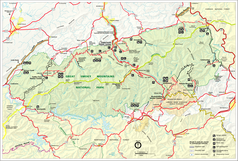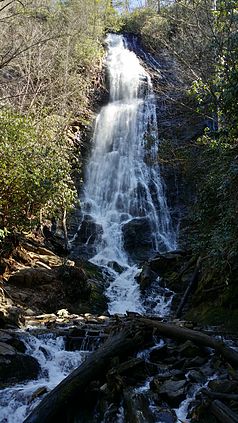Great Smoky Mountains National Park
| Great Smoky Mountains National Park | ||
|---|---|---|
| Panorama of the mountain landscape in the Great Smoky Mountains National Park | ||
|
|
||
| Location: | Tennessee , United States | |
| Next city: | Knoxville, Tennessee | |
| Surface: | 2,114.2 km² | |
| Founding: | June 15, 1934 | |
| Visitors: | 11,421,200 (2018) | |
| Address: |
Great Smoky Mountains National Park 107 Park Headquarters Road Gatlinburg, TN 37738 Tel. (865) 436-1200 |
|
| Waterfall in the national park | ||
The Great Smoky Mountains National Park is located in the Appalachian Mountains in the US states of North Carolina and Tennessee . It was set up on June 15, 1934 and is now a World Heritage Site . The forest that covers the park is one of the oldest forests on earth and the largest area of virgin forest in the eastern United States.
With between eight and ten million visitors, the park is the most-visited national park in the US, but traffic is limited to the major roads. The 450 kilometers of roads off the main paths and the 1400 kilometers of hiking trails in the park are relatively little frequented. The park was named after the Great Smoky Mountains of the same name , in which it is located.
history
Before the arrival of European settlers at the end of the 18th century, the area was part of the homeland of the Cherokee Indians, who gave the landscape the name “Shalonage”, “place of the blue fog” because of the frequent fog. The Indian Removal Act , signed by President Andrew Jackson in 1830, relocated a large part of the Indians living there to other federal areas. The expulsion became known under the English term "Trail of Tears" ( path of tears ). However, some of the Cherokees stayed in this region and were led by the renegade warrior Tsali . They hid in what is now the Great Smoky Mountains National Park. Their descendants still live in the Qualla Indian reservation in the south of the park.
When the white settlers settled, the area developed a thriving timber industry. Wood was a sought-after commodity, and the Little River Railroad , built in the late 19th century and essential to transporting the estate, helped the area prosper and prosper. Wilson B. Townsend, the owner of Little River Lumber, began marketing Elkmont as a tourist destination in 1909. Within a few years, the Wonderland Hotel and Appalachian Club emerged as a summer getaway for the Knoxville elite. In the early 1920s, some members of the Appalachian Club , including Knoxville businessman Colonel David C. Chapman , began to think seriously about a movement to establish a national park in order to put a stop to the immense deforestation . As the head of the Great Smoky Mountains Park Commission , Chapman had extensive powers to raise funds for land acquisitions and to direct park planning activities between local, state, and federal agencies.
The National Park Service supported the request to establish a national park and the American Congress approved the project in 1926. Once additional donors were found to buy the land, farm closings and resettlement began. The official opening of the park took place on June 15, 1934. In 1983 the park was declared a World Heritage Site by UNESCO .
Flora and vegetation
The Great Smoky Mountains are among the oldest mountain ranges in the world. The glaciers that expanded in North America during the Ice Ages reached in their maximum extent to the limits of the park. As a result, they formed a seam between the southern and northern flora. The heights in the park are between 250 and about 2000 meters above sea level . Due to the strong altitude fluctuations, the vegetation in the park comprises a large part of the biodiversity of the eastern United States.
Five different types of forests with more than 130 different tree and 4000 other plant species dominate the Great Smoky Mountains. They represent all of the major forest types of the eastern part of North America. The spruce and fir forest dominates the high altitudes over 1500 meters . In middle locations between 1000 and 1500 meters you will find mainly Nordic deciduous forest . A pine and oak forest grows in the arid areas of the park. Along the river beds wood strips with hemlock encountered (hemlock), and the deep valleys runs through a dense deciduous forest with Linden , maple , horse chestnut and birch .
fauna
The animal population in the park is very diverse, there are more than 60 different species of mammals, including around 1,800 specimens of the symbolic animal of the Smoky Mountains, the black bear, as well as white-tailed deer , marmots , chipmunks , gray squirrels and numerous species of bats . The red wolf , an endangered species that is closely related to the actual wolf, also lives in the northern areas of the national park. About 240 species of birds, 59 species of fish and around 80 species of reptiles and amphibians live in the park . Among them are more than 30 different salamanders , which is why the Smoky Mountains are also known as the “salamander capital of the world”.
geography
The highest point is the 2025 meter high Clingmans Dome , followed by 2018 meter high Mount Guyot . One attraction is the 30 m high overhanging rock cliff of the “Alum Cave Bluff”, which is not only popular with tourists, but also type locality for the rare metal sulfate oxalate minerals coskrenite (Ce) , Zugshunstite (Ce) and levinsonite - (Y) is.
Facilities in the park
The Oconaluftee Valley Open Air Museum houses a collection of historic buildings from the national park's region.
Accesses
- From Knoxville, Tennessee : Interstate 40 , Tennessee Highway 66, US 441 to the Gatlinburg entrance.
- From Asheville, North Carolina: Interstate 40 , US 23, US 441 to the south entrance near Cherokee .
Another access is via the 750 km long Blue Ridge Parkway , which connects Shenandoah National Park with the Great Smoky Mountains National Park. Also, the long-distance hiking the Appalachian Trail runs through the Smoky Mountains.
Web links
- National Park Service: Great Smoky Mountains National Park (official site; English)
- Special website for the park's 75th anniversary in 2009 with lots of information about its history
- Great Smoky Mountain National Park website in German
- Historic Images of the Great Smoky Mountains , University of Tennessee Libraries
- Entry on the UNESCO World Heritage Center website ( English and French ).







